Unbagging E-Man #9
E-Man (Charlton Comics)
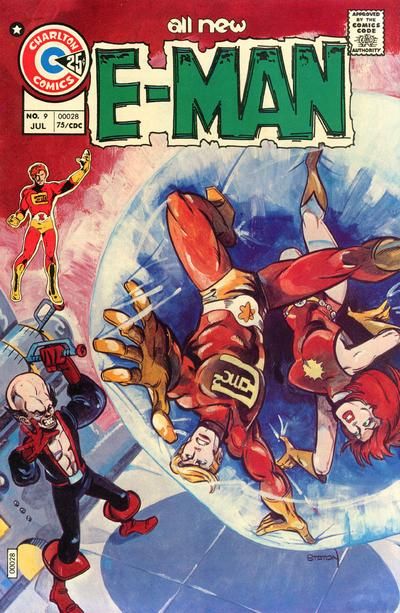
Release: Jul 1975
Cover: Jul 1975
Charlton Comics
Comic | 32 pages | $ 0.25
Creators
| Scripter | Nicola Cuti |
| Artist | John Byrne | Joe Staton |
| Colorist | Wendy Fiore |
| Letterer | Joe Staton |
| Cover Artist | Joe Staton |
| Editor | George Wildman |
Yeah, well, being a lamp post doesn’t make you bright, either.
Last week, I did a Mail Call post about rebuilding my long-lost collection of Charlton E-Man comics, so I thought it was worth doing an Unbagging of an issue for good measure. I considered doing an overall retrospective of all ten issues, but ultimately laziness prevailed, and I decided to focus on just one issue.
The question, then, became “Which one?” After some consideration, I decided on #9 for multiple reasons.
It’s one of the issues I had a copy of back when I was a kid and got that stack of mostly Charlton comics from my mom, it’s one that I remember fairly distinctly, as I must have reread it multiple times before its loss/destruction, it’s one of the issues that takes place after E-Man’s girlfriend Nova becomes a superhero in her own right, and in a strange way – particularly after my recent viewing of Glass Onion: A Knives Out Mystery – it feels somewhat topical.
This issue is also why I mistakenly thought I had the first issue back when I was a kid, thanks to the recap featured on the first page, which made the origin sequence in the first issue seem familiar.
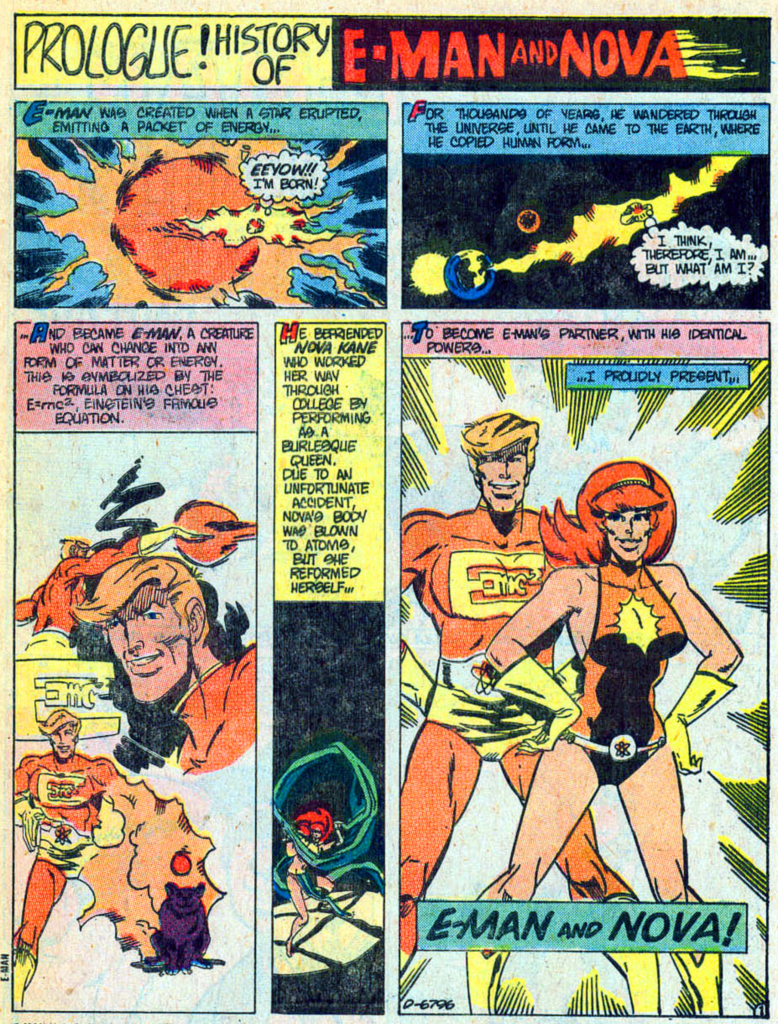
Our story begins with Nova and Teddy – a koala bear that she and E-Man recently acquired in one of their adventures – enjoying a baseball game. As the game ends with the team Nova and Teddy were rooting for victorious, Nova walks out to the field to give a congratulatory kiss to a player she mistakenly believes to be E-Man.
However, when E-Man told her he would be playing First Base he meant it quite literally:
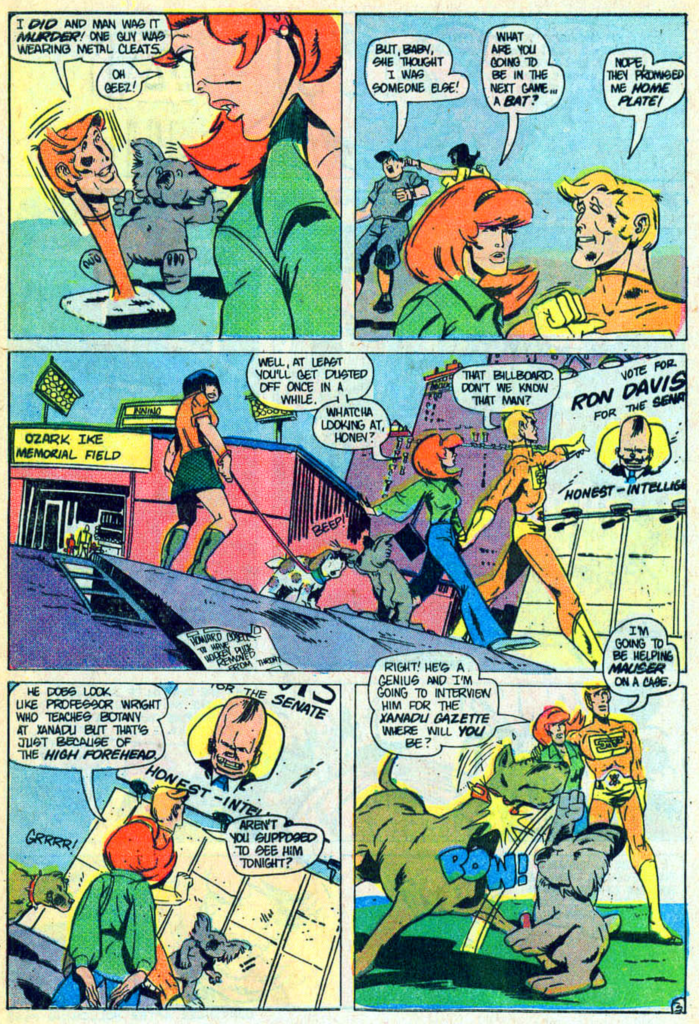
Later that evening Nova meets up with the big-headed Professor Wright who barely seems to notice her as he rants about some strange dead plants in his greenhouse and someone called “Genius One,” who is the only person who knows the formula for keeping those plants alive.
Nova asks him to explain why those plants are so important, but rather than telling her, he shows her.

Immediately after this stunning revelation, a flying drone smashes through the window and kills Professor Wright. Nova uses her powers to save herself once the drone turns its attention to her and transforms into her costume.
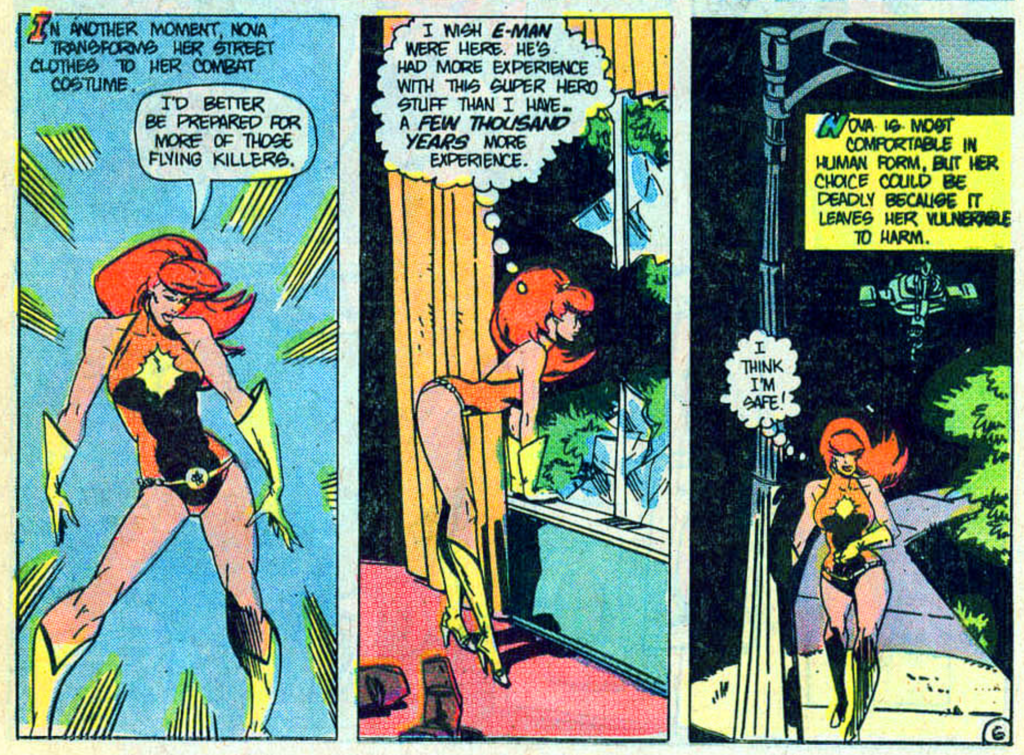
I should note that I always liked Nova’s costume. Yes, in large part because it was sexy, but I also thought it just had the right amount of flair. Honestly, I always liked Nova’s overall character design.
Before she can be killed by the drone sneaking up on her she’s saved by E-Man, who was disguising himself as a lamp post. It turns out that the case that E-Man was working on with Private Investigator Mike Mauser – a case that Mauser refers to as “Highbrow” – is related to the death of Professor Wright. The late professor is just one of many cranially-embiggened individuals in an important position, each one a genius, and each one, as revealed by a General who is working with Mauser, is a member of a secret organization doing the same thing that a certain pair of lab mice does every night: trying to take over the world.
Wright had been cooperating – to an extent – with the US government, which is why he was cut off from the plant that made him a genius and was eventually killed. E-Man and Nova are recruited to travel to the secret, heavily fortified island that serves as the base of operations for the would-be world leaders.
Despite using their shapeshifting abilities to disguise themselves, E-Man and Nova end up getting caught by the big-headed geniuses on the island, all of whom report to the fabled Genius One, who is kind enough to provide his captives with his origin story.
Basically, he and the late Professor Wright were researchers who grew a new species of plant, the consumption of which caused their brains and intellects to expand. Genius One – formerly Carl Metz – fed the plant to several of their students to build an army of geniuses to aid in his plans of world conquest, and he and Wright parted ways.
When Wright was offered the opportunity to join in the conquest, he refused, so Genius One had him killed.
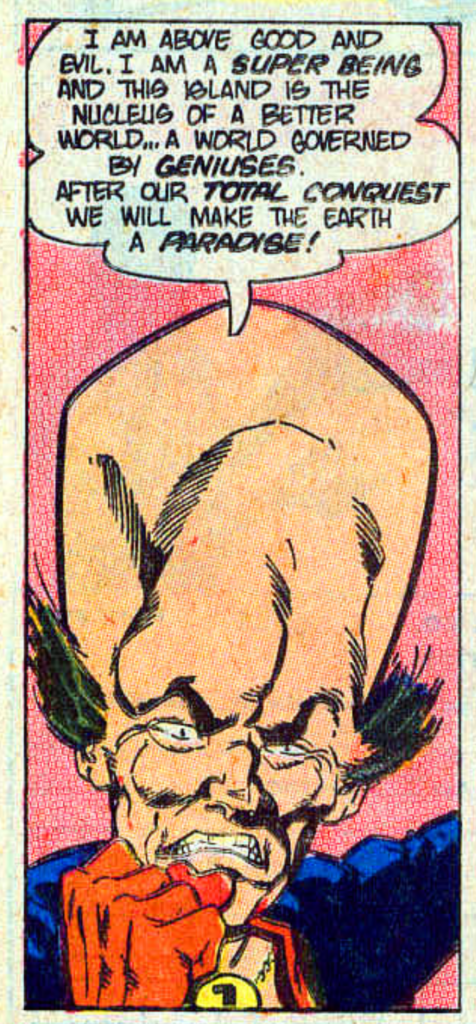
E-Man and Nova eventually save the day by turning into their energy forms and entering the computers that manage the island’s many systems, including the automated feeding of the plants that are required for maintaining the increased intelligence of the island’s inhabitants, causing the plants to be killed by overfeeding. When the effects of the plant wear off, the geniuses’ IQs actually end up being lower than they were before eating the plants, making clean up a breeze for the military.
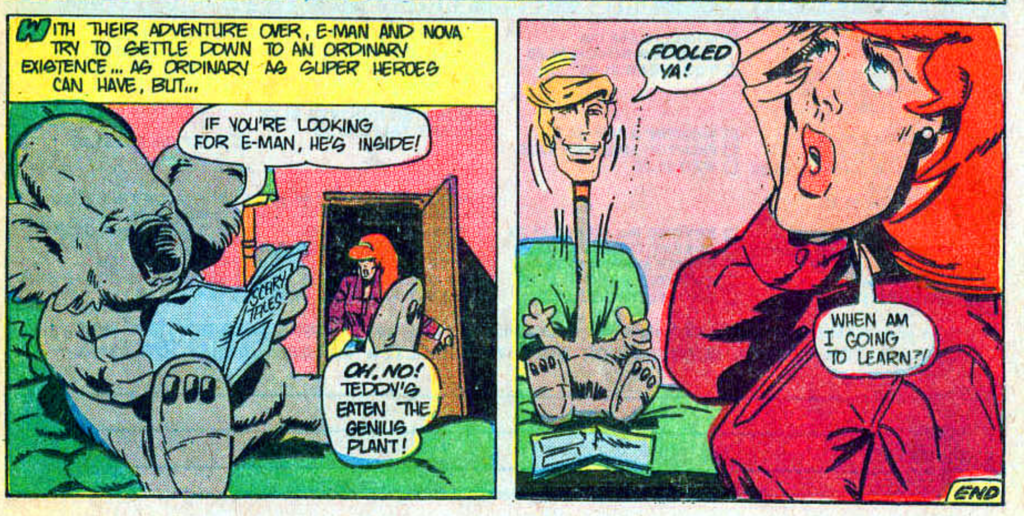
Another reason I chose this issue is that it features a back-up story. Specifically, a back-up story featuring Rog-2000, a wisecracking, cab-driving robot. What makes Rog 2000 notable is that the handful of stories that ran as back-ups in E-Man represent some of the earliest professional work of John Byrne, and Rog-2000 himself was Byrne’s first professional creation.
The simple story involves Rog-2000 being a good Samaritan and saving an old lady from some muggers.
However, the old lady is much more than she appears to be, as Rog is about to learn.
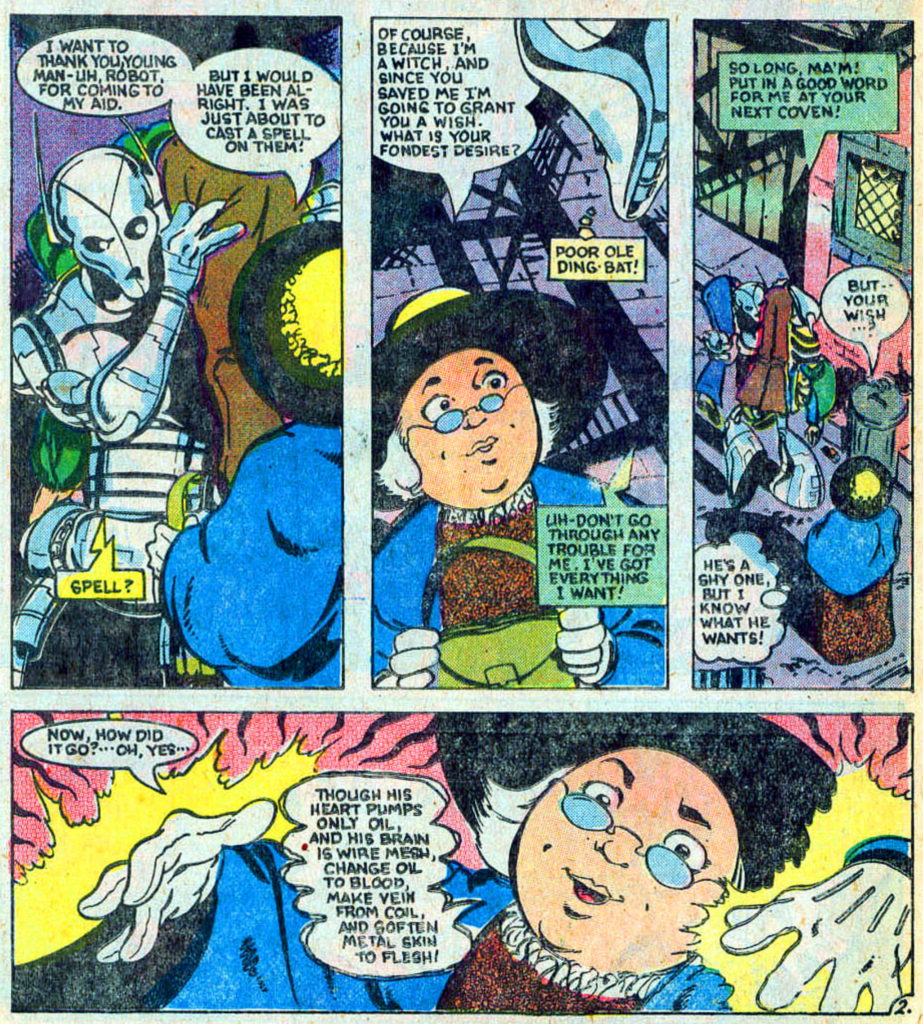
While he writes off the old lady as a loon, while dropping off the would-be muggers at the local precinct, he discovers to his horror that he’s no longer the robot he used to be.

Things go from bad to worse, as it turns out that in his human form Rog-2000 bears an uncanny resemblance to the target of an open mob contract.
Fortunately, he finds the witch and gets transformed back to his old self in the nick of time, and, to the witch’s regret, takes advantage of her offer of a wish.
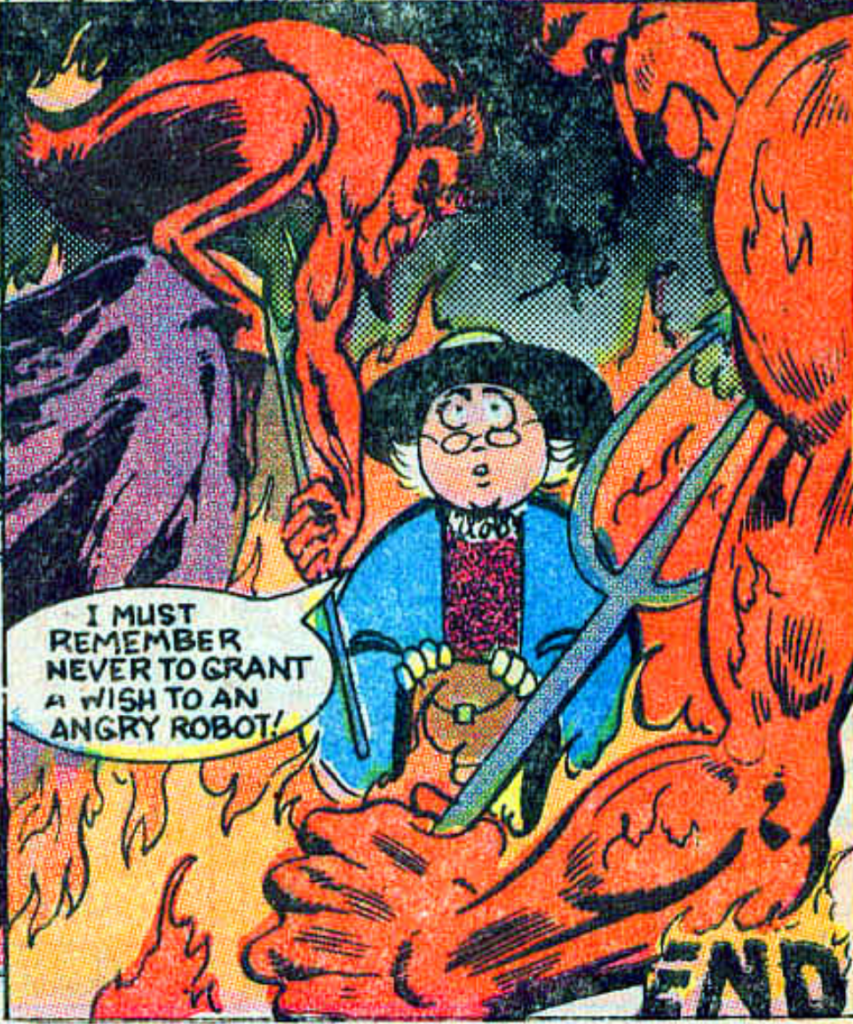
It was just a quick, fun little story, written by Nicola Cuti, who also wrote the main E-Man story, and, again, really only notable for being an example of the early work of an artist who would go on to be a comic book superstar and, to put it very charitably, a temperamental diva.
Anyway, the main event was the E-Man story. Ever since getting those comics all those years ago I’ve had a fondness for the character. In part because of the art of Joe Staton, with whom I was already familiar, although it was work from several years later at DC, most notably in the Huntress back-up stories in Wonder Woman.
Even though my general preference was – and is, really – for more “realistic” styles, I always appreciated Staton’s cartoonish, asymmetrical work. It just has a certain liveliness and character, and something about the curviness of the lines and the way he posed her made Nova seem especially sexy to young Jon.
Beyond the art, I just found E-Man to be fun, similar in many ways to Plastic Man, and to Ambush Bug, another fun character who came along at DC not long after I first encountered E-Man.
Much of the humor in the series comes from puns or silly names, such as Nova Kane and Alec Tronn (the name Nova made up for E-Man), and in this issue, General Dove.
Mike Mauser is also a bit of a jokey name, alluding to the type of gun while also evoking the spirit of the name of some kind of hardboiled detective, but also seemingly some kind of play on Mickey Mouse.
That “seemingly” leads to another point about the series. Even as a kid – I was maybe 9 or 10 when I first read this and the other issues – who often missed certain subtleties, I picked up on the fact that each issue seemed to be engaging in some level of social commentary.
However, it wasn’t always clear just what comments were being made and what they were commenting about. In some cases, it’s a bit more apparent – and it’s even more so in the Killjoy back-ups, with art by Steve Ditko, that appeared in some of the other issues of the series – but in this issue? Even as an older and ostensibly wiser person I’m hard-pressed to figure out what, if anything, about society is being skewered, at least in terms of that particular moment in history.
For me, today, it stood out based on, as mentioned, Glass Onion, which features an island and a narcissistic genius (who isn’t quite the genius he appears to be), and also due to a certain other overhyped “genius” who spends every day being the main character on the social media platform that he apparently bought so that he could spend every being the main character. (And who also provides a lot of inspiration for the character in Glas Onion.)
It just seems to be a bit of a commentary on general technocratic notions and the myth of the great man of history that have been around for a long time, of the Randian ideal, the genius who exists outside the bonds of morality and is destined, entitled, to rule, the kind of geniuses who ultimately aren’t nearly as superior as they think they are. And while that feels more relevant now, today, I suppose it was relevant then as well. It’s just that I can’t pinpoint any specific people or events it might have been a response to.
Of course, unlike most of the “geniuses” we have to hear about these days, these big-headed weirdoes actually were geniuses, as long as they had their plants.
Despite being a Code-approved book, I feel like the audience for E-Man was expected/intended to be a bit older than the typical comic-reader of the day. In part due to the subject matter in terms of the social commentary, which, again, wasn’t exactly the most incisive and was far-removed from the kind of thing you’d find in undeground comix, it still very clearly existed, and in Nova’s occupation as a burlesque/exotic dancer and some of the outfits she (barely) wore both on and off the stage. Beyond that, however, were the ads. Sure, there were your standard mail-order mysteries and encouragement to sell GRIT in order to earn prizes, but there were also a lot of ads for countercultural shirts and posters, and ads for trade schools.
There’s actually a funny contrast between some of the ads for T-shirt iron-ons with vaguely subversive messages and the pro-establishment ads for programs that could lead to a career as a cop.
If nothing else, the comics are a fun artifact of the tumultuous early 1970s just because of the ads.
One other thing I wanted to mention is that it was the letters page for E-Man that sprang to mind whenever I first heard people talking about those fancy, newfangled electronic letters.
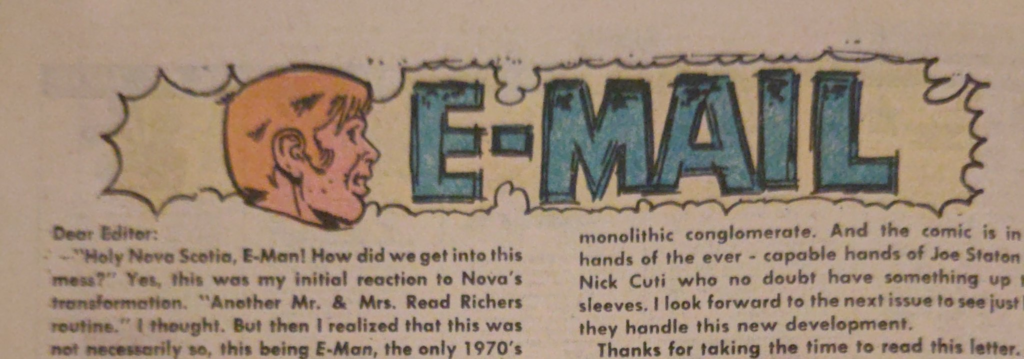

Born and raised in the sparsely populated Upper Peninsula of Michigan, Jon Maki developed an enduring love for comics at an early age.



3 thoughts on “Unbagging E-Man #9”